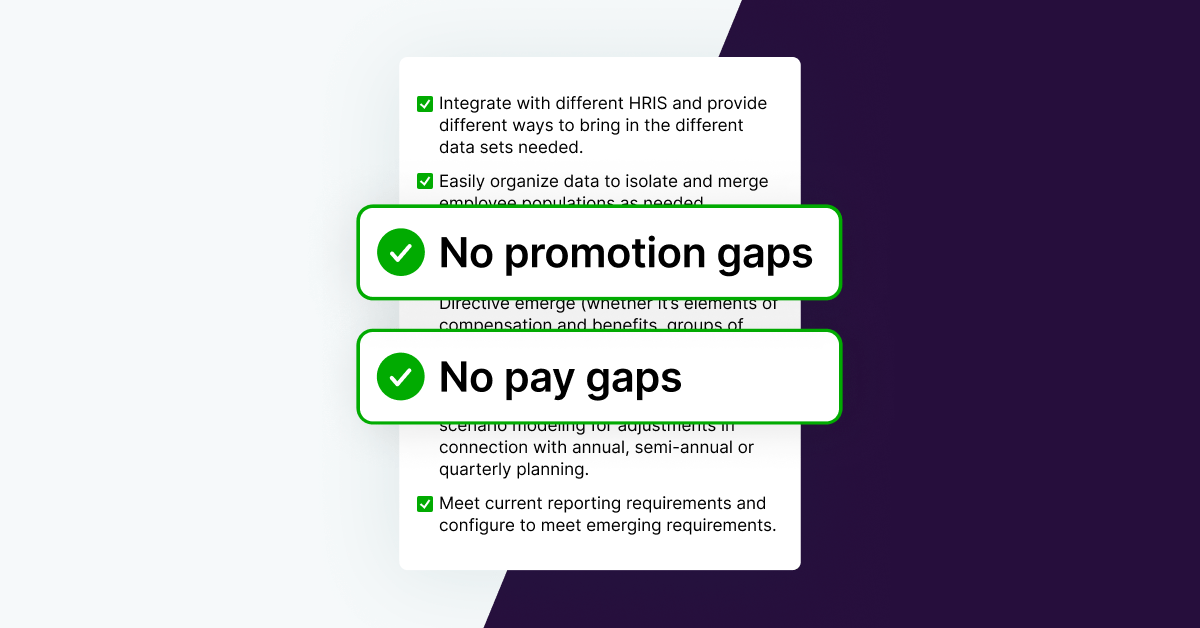We spend a lot of time thinking about the wage gap: its causes, and how companies can transparently share and close any wage gaps that exist. First thing to know is that outcomes in the workplace are far from equal. If you are straight, white, cis-gendered, neurotypical, and read as male, basically every workplace outcome is likely to be better for you.
Sometimes the bias or discrimination that results in the gender wage gap statistics that we see is direct (e.g. getting paid less for the same work), and sometimes it works through indirect mechanisms that have an element of choice (e.g. young women being discouraged from pursuing higher-paying STEM careers and choosing other careers, or early-in-career women opting out of STEM careers because they have bad experiences).
We’ve rounded up 46 wage gap statistics that show the current state of the gender, racial/ethnicity, LGBTQ+, and caregiving wage gaps — and stats that demonstrate why addressing these gaps and promoting pay transparency are not only the right thing to do, but also crucial to a positive employee experience and business success.
Gender wage gap statistics
Women earn only 83 cents for every $1 men earn when examining the gender pay gap. This stat compares all full-time workers. The gender wage gap is smaller if you compare within an occupation, larger if you compare all workers (both full-time and part-time), and largest if you compare all working age individuals. (Bureau of Labor Statistics: First Quarter 2022)
The gender wage gap is larger for women of color. For every $1 white men earn, Asian American, Native Hawaiian, and Pacific Islander women are paid 75 cents, Black women are paid 58 cents, Native American women are paid 50 cents, and Latinas are paid 49 cents. (National Partnership for Women & Families)
Women lose $406,280 over the course of a 40-year career due to the gender wage gap, while for Black women the lifetime earning losses are nearly a million ($964,400). (National Women’s Law Center)
Women in sales roles earn lower base salaries and commissions than men in sales roles, even though they outperformed men by 3-4 percentage points overall. (Inc.)
59% of the time, men were offered higher salaries than women for the same job title at the same company, and Black candidates saw wages that were 4% lower than the baseline. (Hired)
Gender wage gap root cause statistics
On average, women received higher performance ratings than male employees, but received 8.3% lower ratings for potential than men. The result was that women on average were 14% less likely to be promoted than their male colleagues. (MIT Management)
Women are still under-represented in top jobs in 2022, representing 25.2% of the C-Suite in 2022 despite making up 43.4% of the workforce . (Syndio)
Only 8.8% of Fortune 500 company CEOs are women. (Fortune)
While 25% of men earn less than $15 an hour, 40% of women do — and 50% of BIPOC women. (Oxfam America)
Racial/ethnicity wage gap statistics
Black men earn 75.8% and Hispanic men earn 75.4% of what white men earn, comparing full-time workers’ median earnings. (Bureau of Labor Statistics: First Quarter 2022)
Black men earn less on the dollar than male workers of other races, earning just 87 cents for every $1 earned by white men, while Hispanic and Native American men earn 91 cents and Pacific Islander men earn 95 cents. (SHRM)
Executive-level Black men earn 97 cents for every $1 that white counterparts earn, with the same qualifications. (SHRM)
In 2020, the typical Black worker earned about 20% less than the typical full-time white worker. (NY Times)
Racial/ethnicity wage gap root cause statistics
White men in the U.S. are 9.2 times more likely to be in leadership positions than Black women, after controlling for qualified, available talent. (Syndio)
White men hold 35% of entry-level roles and 62% of C-suite roles, with their representation increasing at each level. BIPOC men hold 17% of entry level roles and 13% of C-suite roles, with their representation dropping at each level. (McKinsey & Company)
LGBTQ+ wage gap statistics
LGBTQ+ workers earn about 90 cents for every dollar compared to the median wage for all U.S. workers — and LGBTQ+ people of color, transgender women and men, and nonbinary individuals earn even less. (Human Rights Campaign)
Nearly a quarter of LGBTQ+ Americans have experienced discrimination based on sexual orientation or gender identity when applying for jobs. (The Williams Institute at UCLA School of Law)
While 5.1% of American women and 3.9% of men identify as LGBTQ+, LGBTQ+ women hold only 1.2% of senior manager/director/VP/C-suite jobs and LGBTQ+ men hold only 2.6% of those positions. (McKinsey & Company)
Caregiving wage gap statistics
Working mothers make 75 cents for every dollar earned by working fathers, a pay gap that is even worse for mothers of color: for every dollar earned by white fathers, Black mothers earn 52 cents, Native American mothers earn 50 cents, and Latina mothers earn 46 cents. (National Women’s Law Center)
The typical mother sees her earning power drop by 4% for each child she has, but the opposite is true for men — who see their income rise by 6% upon becoming fathers. (The Balance)
COVID-19 pandemic impact statistics
In February 2022, 1.1 million fewer women were in the labor force than at the start of the pandemic. At that point, men had regained all of their pandemic-related labor force losses. (National Women’s Law Center)
Female job loss rates (5.7%) due to COVID-19 were 1.8 times higher than male job loss rates (3.1%) globally. (McKinsey & Company)
30% of parents who intend to work after COVID-19 think they are likely to make less money than they did before. (Syndio)
Women with kids at home are less likely to continue in or join the workforce after COVID-19 and are much more likely to work part-time vs. full-time, compared to men with kids. (Syndio)
Tech industry equity statistics
Women received 9% fewer interview requests than men in the tech industry in 2021. (Hired)
In the tech industry, men are offered higher salaries than women for the same job title at the same company, 62% of the time — resulting in a 1.8% lower salary for women compared to men in the same roles. (Hired)
Perception of discrimination including salary and benefit inequities and lack of leadership opportunities rose between 2020 and 2021 for both Black technologist respondents and technologists who identify as women. (DICE)
48% of women in STEM jobs report discriminatory recruitment and hiring. (Built In)
Black and Hispanic women who majored in computer science or engineering are less likely to be hired into a tech role than white counterparts. (Built In)
Women in tech are 4 times more likely than men to see gender bias as an obstacle to promotion, which in turn contributes to the gender pay gap. 39% of women see gender bias as a barrier to promotion in 2021. (TrustRadius)
37% of BIPOC women in tech feel that racial bias is a barrier to promotion. (TrustRadius)
53% of Black technologists reported lack of leadership opportunities as the most common form of racial discrimination at their company. (DICE)
Employee and consumer workplace equity statistics
85% of Americans believe it is important for companies to conduct pay analyses. (JUST Capital)
51% of global consumers believe CEOs need to make gender and ethnic pay equality a higher priority. (Edelman Trust Barometer)
58% of U.S. employees would consider switching jobs for more pay transparency. For Gen Z employees, that number jumps to 70%. (Inc.)
Employees who work in a high fairness environment have 26% higher performance and a 27% lower chance of quitting. (Gartner)
Out of 75 essential practices of Employee Experience, “using fair and equitable rewards and recognition practices” was ranked as 6th most important. (The Josh Bersin Company)
The top 3 things that young millennials and Gen Z workers look for in employers are whether the organization cares about employees’ wellbeing, has ethical leadership, and is diverse and inclusive of all people. (Gallup)
99% of millennial investors consider social responsibility in their investment decisions. (Acorns)
Workplace equity business outcome statistics
The average increase in remediation for every year a business waits, or fails, to address inequity is $439,000. (Gartner)
Companies that disclose they’ve conducted a pay equity analysis report nearly 8% higher mean five-year Return-on-Equity. (JUST Capital)
Companies that disclose representation by job group tend to see higher returns. (JUST Capital)
Diverse companies are more likely to financially outperform their peers. (McKinsey & Company)
Companies that make rewards and recognition fair and equitable are four times more likely to have excellent business outcomes and seven times more likely to innovate and adapt to change. (The Josh Bersin Company)
The estimated annual cost of losing and replacing more than two million American workers who leave their places of employment due to unfairness, discrimination, or harassment is $64 billion. (Strategy People Culture)
How companies can make progress on their wage gap
To close their wage gaps, companies have to address both pay equity and opportunity equity at the root. Syndio’s Workplace Equity Platform combined with our team of expert advisors can help you measure and demonstrably improve all facets of workplace equity — from bringing in talent fairly to paying, promoting, and retaining them equitably. Want to see it in action?



